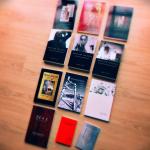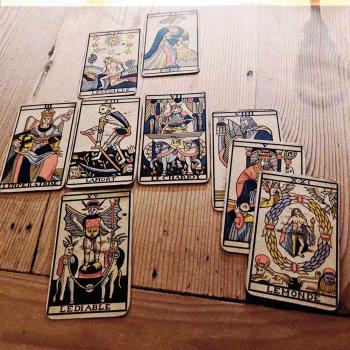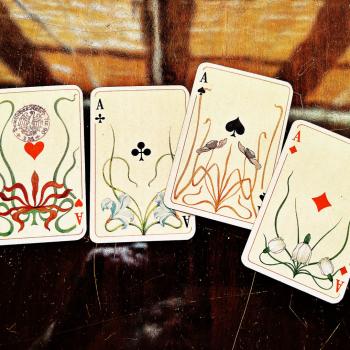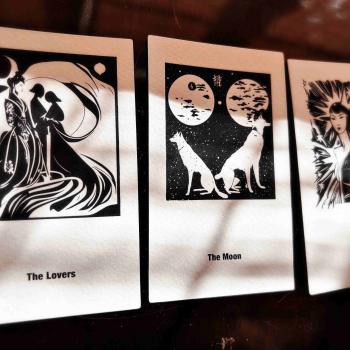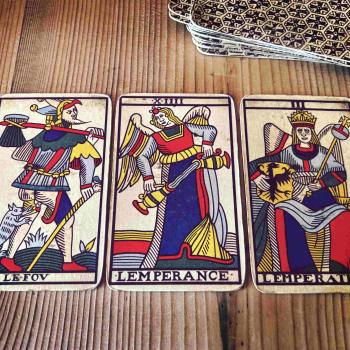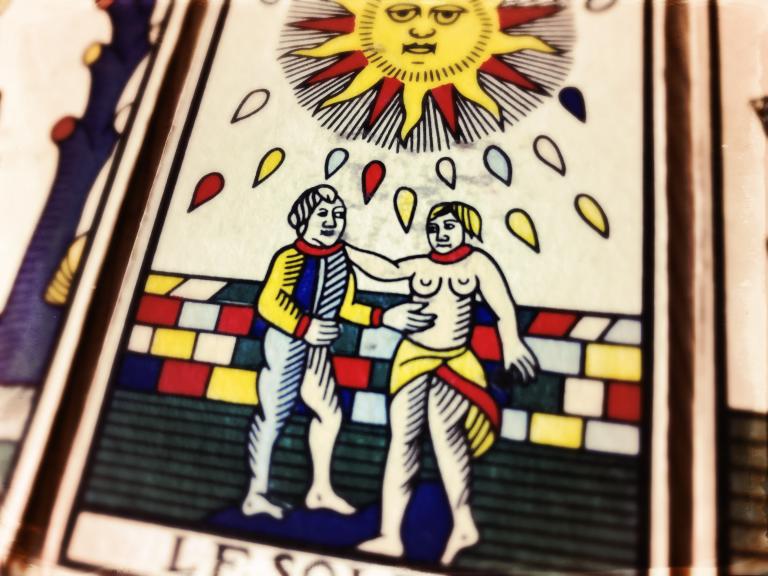
When people come to the fortuneteller to ask a question, they do it out of how they experience an event, how they remember it, and how they project its consequences into the future. So every act of cartomantic transmission is bound to a process of tracing how this event is framed by the questioner’s experience, remembrance, and projection of it. This framing is part of how a querent gives form to what they ultimately stage in their lives as a matter of purpose and course. The task of the fortuneteller is to know the difference between what is already staged and what lends itself to a useful tracing of what is staged so that the imaginary solution provided by the cards can actually beat the imagined reality of the situation.
If this sounds complicated, just think about it: as the experience of something is not the real thing, and neither is the memory or projection of it, what the fortuneteller transacts with as a matter of routine is permuting with fictions. Therefore, and counter-intuitively, what we actually do with the cards is not read them interpretatively, but rather, trace with them the form of what is framed already in the question. In other words, we operate with a superimposed map unto the cards, a map that traces our sense of what weighs more for a querent where their expectation is concerned.
In this sense our cartomancy starts with cartography, with mapping what a querent wants: more nuanced knowledge of their lived experience, or an actual understanding of how such knowledge can be processed so that it becomes an essential part of their lived wisdom. While the two are not mutually exclusive, you will note that there’s a preference, with querents going either for the one or the other, that is, the answer that lends itself more either to description or reflection. If a predictive element is desired, then it follows suit, with some predictions lending themselves to the ‘what’ of the situation while others inviting to a reflection of ‘how’ it will all pan out.
To give an example of how this works in praxis, imagine this scenario from a context regarding an argument between lovers: ‘We had a falling out, because he thinks I lied to him,’ the woman says, implicitly both asking about how to cope with her indignation and, at the same time, staging her preparedness for defense, her eyes glaring: ‘I didn’t lie to him, but he thinks I did.’ When the cards crack open this conundrum towards the imaginary solution, what they offer you is the possibility to trace this woman’s experience, her memory of it that already contains distortion, and her projection of ‘what will happen afterwards.’
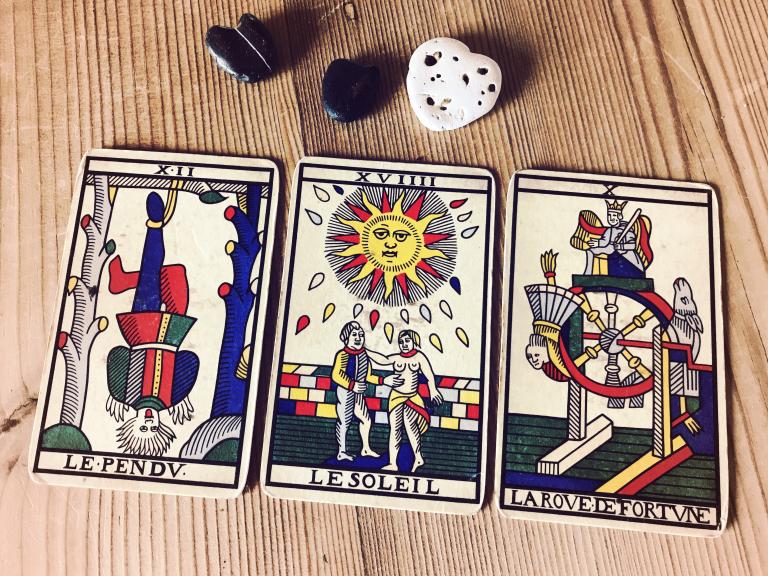
In this case here I got these cards: the Hanged Man, the Sun, and the Wheel of Fortune. The cards enabled me to say this: ‘you got hanged for your love because a third party was caught in the wheel. Maybe you can keep the narratives apart – as in, what the two of you have in common is what the two of you have in common and this is none of the third party’s business – but if your lover can’t keep these two narratives apart, then there’s no resolution, as that would require a reconfiguration of the dynamics of the game.’
The imaginary solution that arises from this tracing can be formulated as a question to the querent: ‘whose logic are you going to use, yours: two have nothing to do with the third, or his: three is one too many in this relationship?’ Whichever perspective you go with, the deeper implication of this also has to do with seeing the role of the Hanged Man here in the first position.
In some esoteric literature on the tarot this card is often seen as a card of sacrifice and self-sacrifice. I’m not so keen on the latter idea, as it’s unlikely that the Hanged Man hangs himself willingly by his foot. It’s also more fascinating to consider that if he doesn’t do it himself, then some other agent is involved. What is this external force or condition that the Hanged Man submits to? The universe, or some other more mundane manifestation?
If indeed, as suspected, the reading is about tracing a love triangle, then who is the sacrificing party and for what? Is the woman querent represented by the Hanged Man, or is the Hanged Man an actual representation of her lover who inadvertently accuses her of falling short of rising to his willingness to share his life with her under the Sun? Whatever agency is embodied here, there is also this question: Are we with a sacrifice in the name of a principle? A promise? Is it for defense, self-defense, or a higher, intangible purpose? Are we with the idea of maintaining the cyclic eternal return of the same because a kinship is identified that exceeds all cultural codes? What of the third one caught in the wheel? How significant is this person? Finally, if this is not a case of self-undoing, then who, indeed, is sacrificing the Hanged Man, and more importantly, on whose altar is this sacrifice put? What is the gain? As we ask these questions, the wheel keeps turning.
As you can see, just by reflecting on the above – and there can be more to think about – you get the sense that the only interpretation that cuts it is the one that actually attempts to trace all the lines that frame the plausible story. Some of these lines are distinct, while others are more subtle. The point is that in any act of observing what is happening in the cards, what you bring to this observation is your curious mind first, and only then your motivation.
If you want a metaphor here for your cartographic cartomancy, you can imagine pouring yourself over your cards at a dark hour in one of those days when the only light is the moonlight, or the shimmer from your candle lit in your solitary cottage in the woods, tracing the obvious hidden in the shadows of the souls that long for a magical touch. On such a day you don’t interpret your cards as ‘the first thing.’ What you do instead is trace the whole arsenal of unarticulated emotions and map it unto the cards as a remembrance that activates your querent’s awareness of impermanence. If there’s a cold shiver around the heart, then your task as a fortuneteller is to warm it up and find the words of love that are not circumscribed by cliché. Then respond in kind.
Now, although this reading above was a reading about an argument that turned out to be precisely a tracing of a love triangle, with the woman dividing her attention between two men, even when that was not put on the fortuneteller’s table, you can extrapolate and see this same scenario in play in other types of relationships: at work, between bosses and colleagues, or at home, between spouses, parents and children. Whenever favoritism arises, or a re-shuffling of ranks especially when there’s no clear ground for it, there’s conflict: ‘I used to work well with my boss, but he is now more invested in my co-worker whom I think is lazy,’ or ‘my eldest son developed envy towards my youngest, his brother, now projecting also the false notion that I favor the youngest over him.’
There’s no end to how people stage their predicament, even when they don’t realize that when they present you with their situation, that is exactly what they do, frame it, remember a particular emotion that sets the stage for this framing, and then project an expectation. Have an eye for the way in which your cards move beneath this cartographic scene, and never lose your tracing line. That is to say, read the cards with view to tracing the form that the querents give to their questions, as it is this form that discloses how a concern is framed, and how a motivation is staged so that it yields a solution.
♠
For more sophistications on the idea of tracing a conundrum with the cards, consult my book, Tarot Tracings: Essays on Literature and Divination (2020).
For more such practice with the cards, join the Read like the Devil Practice Club. Visit also Aradia Academy and sign up for the newsletter that will keep you informed on upcoming courses and cartomantic activities. Note the Off the Shelf offering that also includes free resources.



